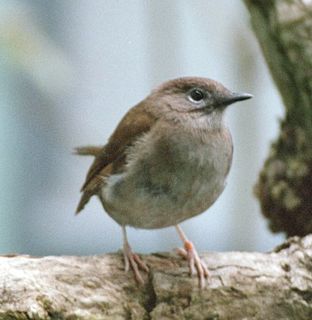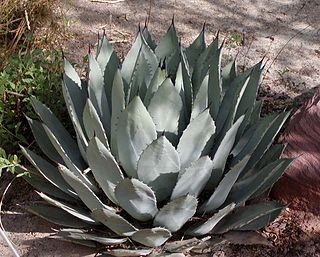
Echinosaura is a genus of lizards, called commonly the spined tegus, in the family Gymnophthalmidae. The genus is endemic to Central America and South America.
The Key tegu is a species of lizard in the family Gymnophthalmidae. The species is endemic to Ecuador.

The Laysan finch is a species of Hawaiian honeycreeper, that is endemic to the Northwestern Hawaiian Islands. It is one of four remaining finch-billed Hawaiian honeycreepers and is closely related to the smaller Nihoa finch. The Laysan finch is named for Laysan, the island to which it was endemic on its discovery. It was subsequently introduced to a few other atolls, and its historical range included some of the main islands.

The curve-billed thrasher is a medium-sized mimid native to most of Mexico and to the deserts of southwestern United States. It is a non-migratory species, and throughout most of its range it is the most common desert thrasher. Several subspecies have been classified since 1827, though there is no consensus on the number. Allopatric speciation is believed to have played a major role in the variations of the curve-billed. It is grey-brown overall with a slightly curved bill, and is similar in appearance to the related Bendire's thrasher. It generally resides in desert regions of the United States and Mexico, but can inhabit areas predominately populated by humans.

The puaiohi, or small Kauaʻi thrush, is a rare species of songbird in the thrush family, Turdidae, that is endemic to the Hawaiian island of Kauaʻi. It is closely related to the other three endemic Hawaiian thrushes, the kāmaʻo, olomaʻo, and ʻōmaʻo. It was first collected by Henry Palmer in 1891 at Halemanu around the entrance to the Kōkeʻe State Park.

The greater koa finch was a species of finch in the family Fringillidae. It was found only in the Hawaiian Islands. It has been extinct since the late 19th century.

Palmer's tree frog is a species of frog in the family Hylidae found in Colombia, Costa Rica, Ecuador, and Panama. Its natural habitats are subtropical or tropical moist lowland forests, subtropical or tropical moist montane forests, and rivers. It is threatened by habitat loss.

Pristimantis palmeri is a species of frog in the family Craugastoridae. It is endemic to Colombia. Its natural habitats are tropical moist montane forests, rural gardens, and heavily degraded former forest. It is threatened by habitat loss.

The grey-and-gold tanager is a species of bird in the family Thraupidae. It is found in Colombia, Ecuador, and Panama. Its natural habitats are subtropical or tropical moist lowland forests and subtropical or tropical moist montane forests.

Palmer's chipmunk is a species of rodent in the family Sciuridae, endemic to Nevada. Its natural habitat is temperate forests. It is threatened by habitat loss.

Quercus palmeri is a species of oak known by the common name Palmer oak, or Palmer's oak. It is native to California, Baja California, Southern Nevada, and in Arizona through the transition zone to the eastern Mogollon Rim, where it grows in canyons, mountain slopes, washes, and other dry habitats. Quercus dunnii Kellogg 1879, common name Dunn oak, is synonymous with Palmer oak. Palmer oak does not occur in New Mexico as the specimen were misidentified and later corrected to Quercus grisea on seinet were the collection records are maintained. The population of golden oaks in Apache Box near Arizona appear to be integrated Quercus chrysolepis Affinity palmeri as stated in the FNA. The population is not Q. palmeri but mostly Q. chrysolepis with past hybridization with Q. palmeri. Quercus palmeri was recently discovered in Southern Nevada in Christmas tree pass that was previously only know from fossils.

Narrow-snouted pipefish is a pipefish species which inhabits the Mediterranean basin: Adriatic Sea, Tyrrhenian Sea, and Black Sea. It is a marine demersal fish with an ovoviviparous breeding pattern.

Agave palmeri is an especially large member of the genus Agave, in the family Asparagaceae. It is native to southern Arizona, southwestern New Mexico, Sonora and Chihuahua. The plant is also frequently cultivated as an ornamental in other regions.
Hesperelaea is a plant genus with only one species, probably now extinct. Hesperelaea palmeri was found only on Guadalupe Island, a small island in the Pacific Ocean, part of the Mexican state of Baja California, about 400 km (250 mi) southwest of Ensenada. The last collection of the plant on the island was in 1875, so the species and the genus must now be presumed extinct. An intensive search for the plant in 2000 was unsuccessful.
Rheosaurus sulcarostrum is a species of lizard in the family Gymnophthalmidae. The species is endemic to Guyana. It is monotypic in the genus Rheosaurus.
Centrosaura apodema, Uzzell's neusticurus, is a species of lizard in the family Gymnophthalmidae. It is found in Costa Rica and Panama. It is monotypic in the genus Centrosaura.
Echinosaura brachycephala is a species of lizard in the family Gymnophthalmidae. It is endemic to Ecuador.
Echinosaura horrida, the rough teiid, is a species of lizard in the family Gymnophthalmidae. It is found in Ecuador and Colombia.
Echinosaura panamensis, the Panama teiid, is a species of lizard in the family Gymnophthalmidae. It is endemic to Panama.













